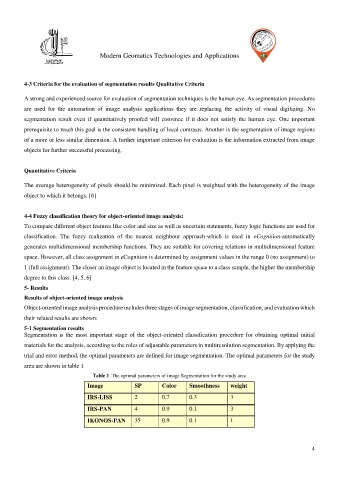Page 325 - NGTU_paper_withoutVideo
P. 325
Modern Geomatics Technologies and Applications
4-3 Criteria for the evaluation of segmentation results Qualitative Criteria
A strong and experienced source for evaluation of segmentation techniques is the human eye. As segmentation procedures
are used for the automation of image analysis applications they are replacing the activity of visual digitizing. No
segmentation result even if quantitatively proofed will convince if it does not satisfy the human eye. One important
prerequisite to reach this goal is the consistent handling of local contrasts. Another is the segmentation of image regions
of a more or less similar dimension. A further important criterion for evaluation is the information extracted from image
objects for further successful processing.
Quantitative Criteria
The average heterogeneity of pixels should be minimized. Each pixel is weighted with the heterogeneity of the image
object to which it belongs. [6]
4-4 Fuzzy classification theory for object-oriented image analysis:
To compare different object features like color and size as well as uncertain statements, fuzzy logic functions are used for
classification. The fuzzy realization of the nearest neighbour approach-which is used in eCognition-automatically
generates multidimensional membership functions. They are suitable for covering relations in multidimensional feature
space. However, all class assignment in eCognition is determined by assignment values in the range 0 (no assignment) to
1 (full assignment). The closer an image object is located in the feature space to a class sample, the higher the membership
degree to this class. [4, 5, 6]
5- Results
Results of object-oriented image analysis
Object-oriented image analysis procedure includes three stages of image segmentation, classification, and evaluation which
their related results are shown:
5-1 Segmentation results
Segmentation is the most important stage of the object-oriented classification procedure for obtaining optimal initial
materials for the analysis, according to the roles of adjustable parameters in multiresolution segmentation. By applying the
trial and error method, the optimal parameters are defined for image segmentation. The optimal parameters for the study
area are shown in table 1
Table 1 .The optimal parameters of image Segmentation for the study area
Image SP Color Smoothness weight
IRS-LISS 2 0.7 0.3 3
IRS-PAN 4 0.9 0.1 3
IKONOS-PAN 35 0.9 0.1 1
4

